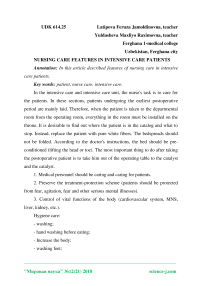Nursing care features in intensive care patients
Автор: Latipova Feruza Jamoldinovna, Yuldasheva Maxliyo Raximovna
Журнал: Мировая наука @science-j
Рубрика: Основной раздел
Статья в выпуске: 12 (21), 2018 года.
Бесплатный доступ
In this article described features of nursing care in intensive care patients.
Patient, nurse care, intensive care
Короткий адрес: https://sciup.org/140263277
IDR: 140263277
Текст научной статьи Nursing care features in intensive care patients
In the intensive care and intensive care unit, the nurse's task is to care for the patients. In these sections, patients undergoing the earliest postoperative period are mainly laid. Therefore, when the patient is taken to the departmental room from the operating room, everything in the room must be installed on the throne. It is desirable to find out where the patient is in the catalog and what to stop. Instead, replace the patient with pure white fibers. The bedspreads should not be folded. According to the doctor's instructions, the bed should be preconditioned (lifting the head or toe). The most important thing to do after taking the postoperative patient is to take him out of the operating table to the catalyst and the catalyst.
-
1. Medical personnel should be caring and caring for patients.
-
2. Preserve the treatment-protection scheme (patients should be protected from fear, agitation, fear and other serious mental illnesses).
-
3. Control of vital functions of the body (cardiovascular system, MNS, liver, kidney, etc.).
Hygiene care:
-
- washing;
-
- hand washing before eating;
-
- Increase the body;
-
- washing feet;
-
- haircut;
-
- nose treatment;
-
- eye treatment;
-
- ear training;
-
- oral cavity treatment;
-
- changing clothes and underwear;
-
- change of whiteness.
Treatment-prophylactic care:
-
- control of postoperative injuries and drainage;
-
- prevention of bed sores;
-
- preventing lung complications;
-
- prevention of phlebitis (activation of patients, treatment physiology, elastic bandage on feet);
-
- Prevention of purulent complications (strict observance of aseptic rules);
-
- prevention of thromboembolic complications;
-
- paresis by the intestines and urine separation system
prevention.
Physiological Needs Assistance:
-
- feeding;
-
- drinking liquids;
-
- Putting towels;
-
- urinary incontinence;
-
- urine allocation, catheter bladder or permanent catheter;
-
- Cleaning the feces if it is difficult to separate.
Basic technique of care for patients
Recovery of patients treated in intensive care and intensive care departments depends on proper care. Death ending may take place as a result of its illness, not its main disease. Only skilled nursing can be prevented, otherwise modern methods of intensive therapy may be ineffective.
Prepare conditions. In most cases, the condition within the patient is a treatment object. The attention of nurses should be focused on the preservation and improvement of the environment, that is, the situation around the patient.
The divisions and premises must have the following conditions: Everyone should have the opportunity to observe each patient and approach each bed separately using the special equipment for separation of patients, resuscitation and monitoring. The intensive care unit should also have free access to duty officers, assistants and technicians. Mobile tables with electrode defibrillator, "Ambu bagu", electric shave, intubation and central blood vessels collection, syringes, syringes, infusion systems, medical materials and medicines should always be ready.
Must be isolated from isolators and visitors. The room should have fresh air, proper temperature (24 ° C-26 ° C), and moisture levels, and cleanliness of floor and floor area. Due to the need, the patient has to spend 24 hours in the bed, so they need to be time consuming over time and night and day to know the date. Preserving the purity. Patients receiving intensive care unit are very weak and have reduced immunity. In order to prevent secondary infection and prevent its occurrence, the nurse should regularly perform hygienic procedures. Hygienic procedures also help to increase the patient's mood. The following hygienic treatments are performed:
Purification of the oral cavity of the severe patients. In the mouth and nasal cavity, various tubes are inserted - the body's self-cleaning function may be reduced, which can lead to infections. At least 3 times a day to clean the teeth or rinse the mouth. Two nurses have to hold the tubes and immediately perform hygienic procedures for the oral cavity and then replace the tubes.
Список литературы Nursing care features in intensive care patients
- Барыкина Н.В., Зарянская В.Г. Сестринское дело в хирургии. - Ростов-на-Дону: «Феникс», 2010.
- Hamrayev A.J., Xamedova M.A. Xirurgiya. - T.: «O‘qituvchi», 2009.
- Ziyayeva M.F. xirurgik kasalliklar bilan og‘rigan va intensiv terapiyani o‘tayotgan bemorlarda hamshiralik parvarishi. -T., Niso poligraf, 2017.


